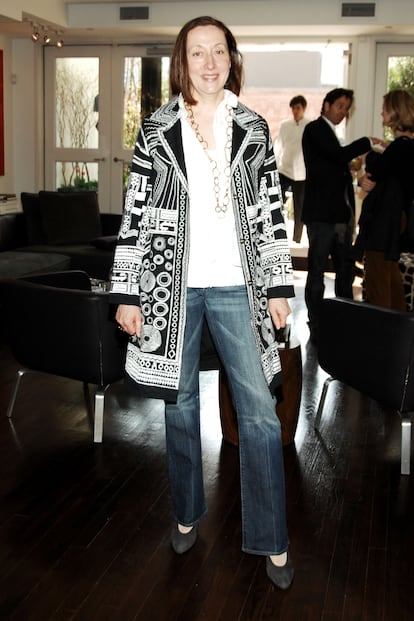In the mid-nineties, the sculptor Vera Lutter (Germany, 64 years old) moved to New York. Installed on the 27th floor of an old building in the Garment District and in order to capture the intensity of a landscape much more hectic and dense than what the Old World offered, she decided to convert her apartment into a camera obscura. He sealed all the cracks of light, so that it could only enter through a thin hole drilled in a blackened window. On the opposite wall he placed a light-sensitive paper. The stage was set. Little by little the light would do its work and the outside world would be projected inverted on the photographic paper.
Since then, photography became the artist’s means of expression, and the camera obscura—a device whose origins date back to the 5th century BC in China—her main ally. Sometimes his images require an exposure process of hours, other times days or months. The result is a negative, in large format and in black and white. “Halfway between the rigor of a scientific procedure and the magic of a shamanic rite,” as Francesco Zanot, curator of SPECTACULAR. An Exploration of Light. The exhibition, which takes place at the MAST Foundation in Bologna, Italy, until January 6, brings together for the first time a wide selection of Lutter’s work. 20 majestic and delicate unique pieces that speak of space, memory and time. Focused on landscapes related to industry, work and infrastructure that facilitate the movement of people and goods, they are sublime and timeless. Familiar places that, under the gaze of the German photographer, appear like mirages and, although recognizable, invite the viewer to a closer observation; to get lost among its innumerable details, attracted by the strange presences that seem to inhabit them.
“The city seen from the Queensboro Bridge is always a city seen for the first time, promising a wild first glimpse of all the mystery and beauty of the world,” wrote F. Scott Fitzgerald in The Great Gatsby. The flash of a city that the artist thought she identified while she was giving shape to the first series of images made outside her loftat the Pepsi Cola factory. To do this, he built a chamber, the size of a room, inside the factory (a process is repeated in each of his series, by which the camera obscura not only functions as an image factory, but is itself the object of a manufacturing process). From there, it would come Pepsi Cola, Long Island City, IX: July 2, 1998, where the theatricality of the logo, an icon of pop culture, stands out, supported by an entire network of scaffolding, with the rawness of the city as a background.

Although on this occasion Lutter will help the viewer orient himself, placing the camera behind the anagram, so that the negative can be read correctly, his works often leave a lot of room for uncertainty. The photographer plays with the semantics of positive and negative in digital photography. He frequently introduces mirrors that will alter and duplicate the space, taking the viewer into labyrinths, which, at the same time, allow him to see things that he would not otherwise be able to appreciate. The author delights in the idea of the image of an image, and in the layers of ephemerality that this implies. “It is both a game and a questioning of what an image really is,” Lutter points out. “My work is a continuous creation of fictional spaces,” he adds. The large formats used allude to Cinquecento painting and in them photography loses the false concept that associates it with what is small and manageable. Lutter’s work is great in both its format and its execution.
There is no human trace in any of the landscapes. Not in the old Battersea power station in London, nor in the Hambach coal mine, one of the largest in the world, nor on the runways of Frankfurt airport. In the same way that El Temple Boulevard (1838) by Daguerre appeared deserted, due to the long exposure times required, anything that moves quickly cannot be captured. “Photography, after all, never shows things as they are, but rather interprets them and transforms them into other things. Appearances. Ghosts,” writes Zanot in the catalog that accompanies the exhibition. “The negative highlights the structure of the subjects, tracing their skeleton: what remains before they disappear.”
In the same way, we could say that Lutter’s work is the result of many temporalities. It does not capture a moment, but the sum of many moments, as happens in our memory. “Time is a fundamental element in my work. Together with the light and the camera they form a triangle where they interact with each other. The less light, the more time, the larger the camera, the larger the image will be and more time and more light will be needed… so time is something that makes sense in itself for practical reasons,” warns the author.
In the same way that the work of the German photographer is deeply linked to some of the first images and methods in the history of photography, the exhibition highlights the value of analog photography in a world extremely attached to the immediacy of digital. In Lutter’s negatives, light becomes shadow and shadow becomes light, immersing the viewer in an enigmatic and gelatinous dream where perception is constantly decomposed and reconfigured. A constant game between the tangible and the intangible, the present and the past, which not only invites us to reflect on the very essence of the image, but also challenges our relationship with time, and the way in which we perceive reality.
